Lung volumes and capacities are measurements that reflect the mechanics of breathing and the volumes of air associated with different phases of the respiratory cycle.
These measurements are crucial for assessing respiratory health and function.
There are four primary lung volumes and four lung capacities, which are combinations of different volumes.
Lung Volumes
1) Tidal Volume (TV)
Definition: The volume of air inhaled or exhaled during normal, quiet breathing.
Average Value: Approximately 500 mL in healthy adults.
2) Inspiratory Reserve Volume (IRV)
Definition: The additional volume of air that can be forcefully inhaled after a normal tidal inhalation.
Average Value: Around 1900-3300 mL in healthy adults.
3) Expiratory Reserve Volume (ERV)
Definition: The extra volume of air that can be forcefully exhaled after a normal tidal exhalation.
Average Value: Approximately 700-1000 mL in healthy adults.
4) Residual Volume (RV)
Definition: The volume of air remaining in the lungs after a maximal forced exhalation. This air cannot be expelled and helps maintain lung function.
Average Value: Typically, 1000-1200 mL in healthy adults.
Lung Capacities
1) Inspiratory Capacity (IC)
Definition: The total volume of air that can be inhaled after a normal tidal exhalation.
Formula: IC = TV + IRV.
2) Functional Residual Capacity (FRC)
Definition: The volume of air remaining in the lungs after a normal tidal exhalation.
Formula: FRC = ERV + RV.
3) Vital Capacity (VC)
Definition: The maximum volume of air that can be exhaled after a maximal inhalation.
Formula: VC = TV + IRV + ERV.
4) Total Lung Capacity (TLC)
Definition: The total volume of air that the lungs can hold after a maximal inhalation.
Formula: TLC = TV + IRV + ERV + RV.




